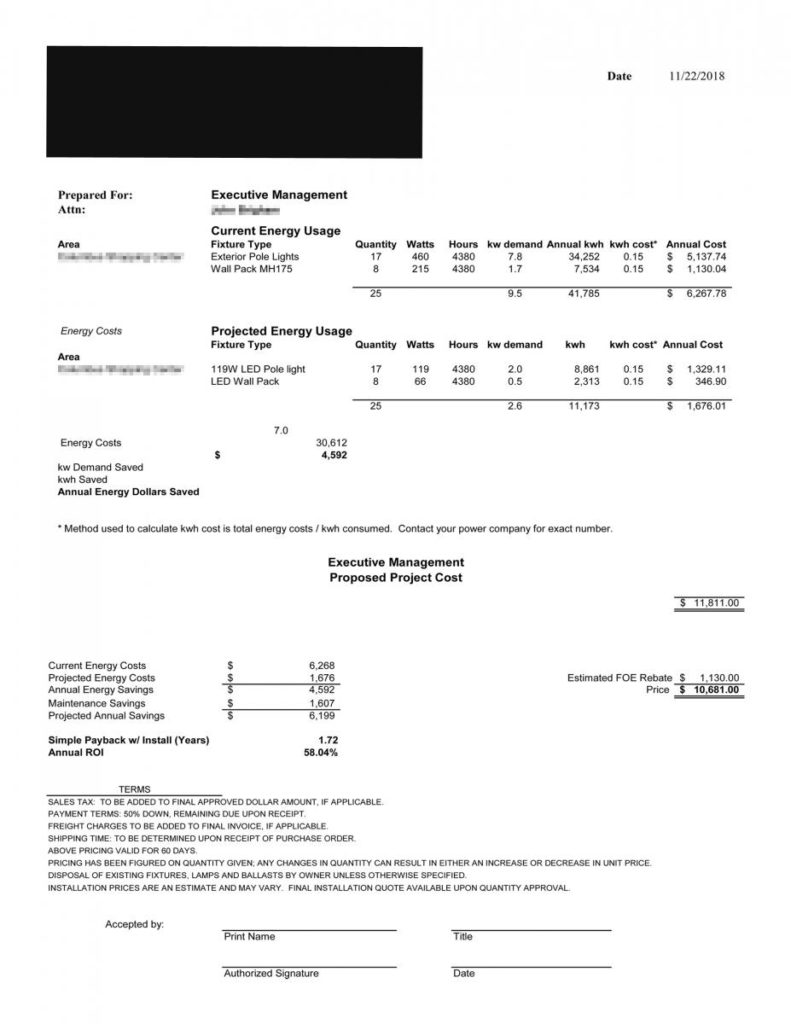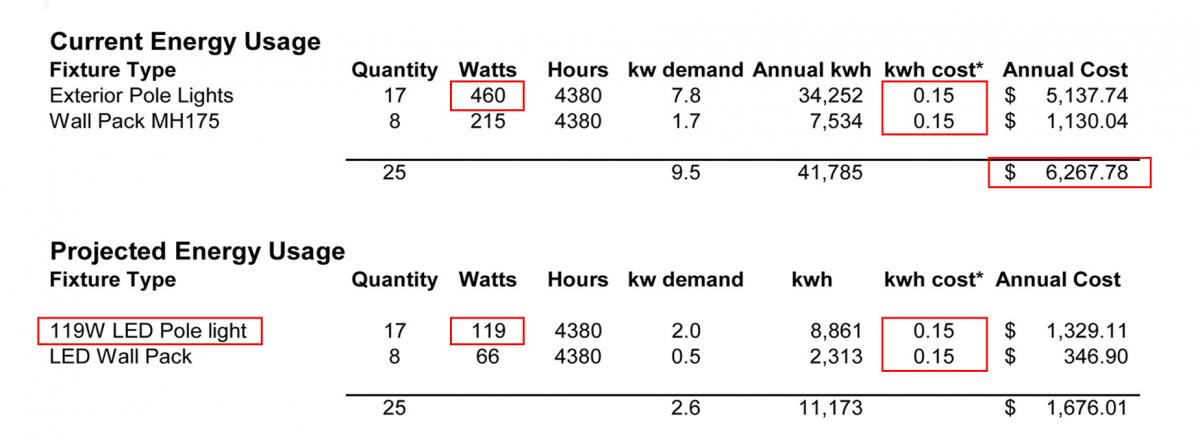
Hiring a good lighting contractor is not an easy task. There can be dozens – or even hundreds of options out there – and every person you ask has different advice and recommends a different company to work with. There should be no rush when choosing a contractor, because making the wrong choice can have big consequences.
When upgrading an essential utility—like your commercial lighting system—you should know that working with a qualified, reputable contractor is crucial to project success, length of payback and the project’s ROI (return on investment). Working with a crooked contractor will not only waste your time and money, but can put the entire project at risk.
Energy Performance Lighting researched the biggest industries—including commercial, healthcare, government, and education—to determine the top warning signs to use when weeding out contractors who may not live up to your standards:
1. Contract Complications
You should be very wary of any lighting contractor who wants you to sign-off on a vague contract or attempts to reach a “verbal” agreement; a proper contract protects both you and the contractor. You should have all the information, such as payment details, product info, schedule, and the scope of work involved with the project before agreeing to commit. Make sure to look over the contract carefully so you understand exactly what you’re agreeing to. Each part of the project that’s been established should be included in writing at the time of the contract signing.
Blank lines, cryptic language, and vague wording are red flags you should question before signing any contracts. If a contractor is hesitant to include what you agreed upon in writing, there’s a big chance they won’t stay true to their word. Without a proper contract in place, some negative situations that can arise are:
- The contractor does a poor job, but you have no record to prove the quality of work for the project.
- The contractor runs away with your money before finishing the project. Without a contract to prove they were supposed to do the work, you could be out-of-luck.
2. No Permanent Business Address
Although this doesn’t necessarily represent a bad contractor (as most contractors do their business on-site), the person or company you’re doing business with should have a local business office. Without a local office, there isn’t much stopping the contractor—or company—from walking off with your payment. Contractors without a permanent address for their business also run the risk of being unlicensed, avoiding permits, and being uninsured.
3. Significantly Lower Bids
When it comes to an energy-efficient upgrade, or any type of performance upgrade or remodel for that matter, the lowest bid is rarely the best option. Contractors who offer a substantially lower price compared to other contractors may be cutting corners on labor or using cheap materials. A good way to verify if a contractor is inexperienced, or underestimating the costs of a project, is to ask them if the scope-of-work matches the proposal they provided.
In most cases, the contractor may have missed one or two line items. However if the contractor confirms they bid the job correctly, and price provided is a lot lower than their competitors, there’s a chance this may be a contractor to avoid.
4. Bad Reviews
One of the first things you should do when researching a contractor in the “age of technology”: get opinions of their work from previous customers. Nowadays, the internet is a great resource to find honest feedback about commercial lighting contractors. If they don’t have good reviews and positive customer feedback, they may not be the best choice to work with. Find reliable online review sources such as Yelp!, Google reviews, and even reviews on their social media pages. It should be noted, that although one bad review may not indicate a bad contractor, if the company or contractor has bad reviews, you should proceed with caution.
5. Too Many Subcontractors
Good lighting contractors know how to use subcontractors wisely. If a contractor is overly-reliant on the use subcontractors, that should raise a red flag. Ask your contracting company if they have a dedicated team to complete your project, or if they hire a lot of subcontractors to do the work. This shows that the contractor (or organization) you hired is simply an unnecessary middleman, organizing and farming out most of the work, rather than an essential piece of the process. Always expect to pay a premium price if there is high use of subcontractors.
6. Not Providing References
A credible contractor with a positive work history should be eager to provide multiple references and/or referrals to their potential clients, so they can show off how excellent their abilities are, and brag about how happy their previous clients are with their work. If the lighting contractor you’re interested in hiring is not comfortable with providing the names and contact details of their previous clientele, there’s a chance that they have a sour reputation among old clients, and should set off some bells.
It’s important to remember that a single reference is not enough—your lighting contractor should have a long list. Don’t feel bad for putting in the effort to thoroughly vet each candidate upfront. Taking the time to choose the right contractor for the project will save you from potential headaches down the road.
7. Incorrect, Misleading, or Skewed Information
In an attempt to improve bottom-line numbers, some lighting contractors may deliberately skew or use incorrect information. Take this company’s proposal for example:

At a glance, this may seem like your average lighting retrofit proposal, but once we inspect the numbers closer, we find the information is either incorrect, or misleading, affecting the projected cost savings and the project’s payback window. We’ve highlighted some incorrect or misleading information in the examples below:

Under Current Energy Usage (in the image above), the “Watts” listed for Exterior Pole Light fixtures is an overestimate; we know it’s an overestimate based on the length of the pole the lights are mounted on. Typically, a 30-foot pole fixture would have 460w lights installed, however, having done work for this property in the past, the specialists at Energy Performance Lighting know these pole fixtures only measure 18-feet. So in actuality, these fixtures only produce 270w.
The “kwh cost” listed is also incorrect. Based on information provided by the municipally-owned utility that provides power to this property – the actually kwh cost is .085 – nearly HALF the cost listed in the proposal! If we take the correct numbers and pair them with the property’s current energy usage, we find that the real annual cost is $3,551.81; a difference of $2,715.97 than the annual cost provided.
Misleading numbers like these can have an enormous impact, often doubling the length of time for payback, and halving the project’s ROI.

This example (pictured above), displays why a proposal’s terms of agreement should be thoroughly examined before signing a contract. We’ve highlighted the terms involving: sales tax, freight charges, and disposal, because they all make a direct impact on the proposition’s payback and ROI, and should be brought up any time you’re working with a contractor.
It is good practice to get a second or even third opinion from another contractor (in this case, another reputable lighting company) to verify that the numbers provided to you representing energy costs and energy consumed are accurate.
Always double check the terms of the proposed project as well. Certain project terms like sales tax, freight charges, and unit quantity can affect the projects ROI and payback conditions. You should also verify with the contractor who will handle the disposal of the existing materials. If the disposal of materials is left up to you, you may have additional costs and fees associated with your project.
Bottom Line
It can be a real challenge finding the right contractor or company to contract for your lighting retrofits. It’s important to work with a credible business to ensure that your lighting project is completed successfully. If you’re mindful of the red flags listed above, and make sure to stay away from the contractors that present them, you’ll be well on your way to successfully completing your lighting upgrade(s).
At Energy Performance Lighting, we pride ourselves on being the best value for our clients, not the lowest bid. We provide a fair bid from the get-go and won’t nickel and dime you along the way. We’re brand neutral and committed to being on the leading edge of the latest advancements in the industry. EPL offer’s “Good-Better-Best” options and will work to educate you and your team on recommendations, options, and tradeoffs. Energy Performance Lighting delivers the best lighting upgrade solutions. Period.
Get in-touch with one of our lighting experts today! Give us a call at (608) 661-5555, send us an email, or visit our office at 243 Bonnie Road in Cottage Grove, WI.



